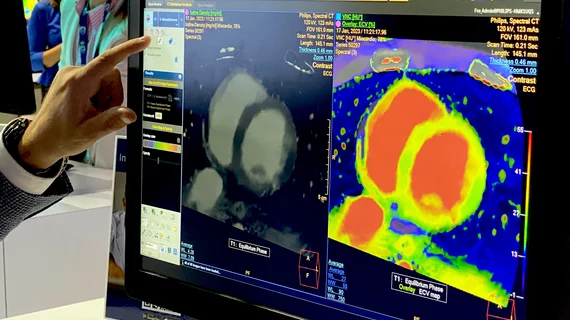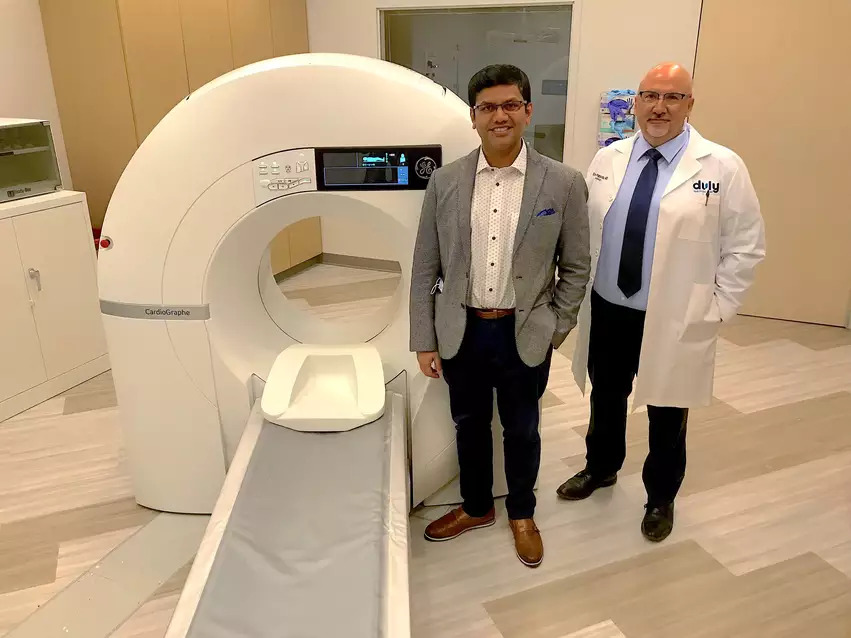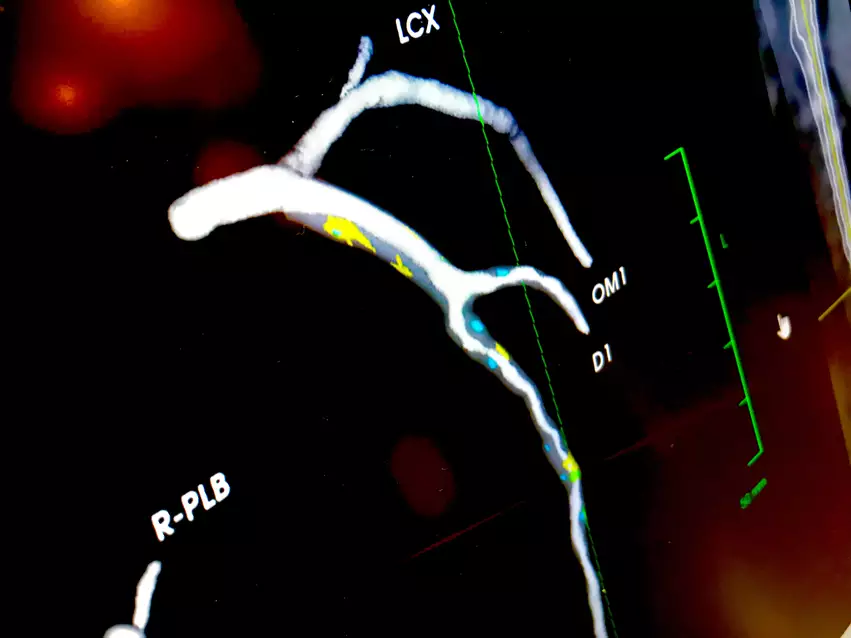Cardiac CT's continued rise on display at RSNA 2023
Coronary computed tomography angiography (CCTA) has seen rapid adoption and growth since it was granted a Class 1A recommendation for front line imaging in the 2021 American Heart Association (AHA) and American College of Cardiology (ACC) Chest Pain Guidelines. There was already anecdotal evidence cardiac CT has been on the rise, but vendors reinforced that belief with new product launches at the world's largest radiology conference, the Radiological Society of North America (RSNA) 2023 meeting.
CT vendors Siemens, Canon and Hitachi launched four new scanners at RSNA, all targeted at cardiovascular CT. It is unusual that this many new CT systems would be launched in one year at RSNA, but it shows that vendors are taking the modality more seriously than in the previous decade. All vendors said their new systems have enhanced coronary imaging capabilities to meet the demand they are seeing for these types of systems.
"The key area everyone is targeting now is coronary imaging, since CT now has the Class 1 indication. So we are seeing rapid expansion of coronary CTs that we are doing and a lot of other centers are seeing too," cardiac imager Albert Hsiao, MD, PhD, professor in residence for radiology at UC San Diego, told Cardiovascular Business.
Many healthcare systems have seen bumps in CCTA imaging volumes over the past two years, some very significant. Northwell Health, the largest health system in New York, has seen more than a 200% increase in CCTA exams. Other systems such as Mass General Brigham in Boston have also reported large increases in cardiac CT.
Another indicator of growth and interest is conference attendance. While many medical societies are still recovering their attendance numbers from the pandemic, the Society of Cardiovascular Computed Tomography (SCCT) 2023 meeting saw record-breaking attendance above its pre-pandemic numbers. SCCT's hands-on, how-to training sessions were sold out, showing the rising interest in how to perform these exams.
"This is a trend where there is definitely a shift in the needle with the types of procedures that are being performed on CT systems. Changes in the guidelines recommending CT for coronary artery screenings led to multiple vendors launching new CT systems and other technologies which enable better coronary artery disease screening. This helps patients by avoiding admissions to hospitals for invasive procedures in the cath lab," explained Bhvita Jani, medical imaging principal market analyst for Signify Research.
Jani said the U.S. is actually lagging behind other countries in Europe, which embraced CCTA several years ago as a front line cardiac imaging test. In 2017, CCTA was adopted as the preferred first-line test in the U.K. National Institute for Health and Care Excellence (NICE) guidelines for the evaluation of chest pain in patients without known coronary artery disease (CAD). That recommendation was based, in large part, on an analysis performed by economists evaluating the incremental cost and care benefit of various diagnostic strategies.
RSNA had numerous cardiac imaging sessions and there were efforts in some presentations this year to promote CCTA and try and drum up interest on the radiologist side as more centers adopt cardiac imaging.
"I predict in the next four to five years, we are going to see a lot of growth in cardiac CT and we are going to need more people. We already see that interest coming from the cardiology side. I am talking to colleagues here at RSNA, and there is also interest on the radiology side," explained Joao Cavalcante, MD, section head for cardiac imaging for the Allina Health Minneapolis Heart Institute, who presented several cardiac imaging sessions at RSNA.
New cardiac CT capable scanners launched at RSNA
Siemens launched the Somatom Pro.Pulse, a new dual-energy CT system being sold at a standard single source CT system price point. The vendor said it was released partly to address the rapidly growing demand in cardiac CT. It uses an air-cooling system to reduce the cost of ownership and has applications for cardiac imaging, along with brain, lung, MSK and thoracic imaging. It has a temporal resolution of 83 miliseconds to freeze cardiac motion, even in patients with higher heart rates.
Siemens also stressed the cardiac imaging benefits of its Naeotom Alpha system, the first commercialized workhorse photon-counting CT system. Photon-counting for cardiac imaging was also discussed in several sessions at RSNA. Experts in CT say photon-counting offers many technical benefits that will likely make it become the primary CT imaging technology in the next decade. It has about twice the resolution of conventional CT scanners and integrates spectral CT data into every scan. GE and Philips are also developing their own versions of this technology.
Canon unveiled two new scanners at RSNA. This included a new flagship system, the Aquilion One Insight Edition 640-slice, 8 cm coverage system. It is able to scan a heart beat or brain in one rotation. It is twice as fast as previous versions of the Aquilion One. The other system, for high-throughput, is the Aquilion Serve SP. It is a 160-slice scanner with 4 cm of anatomical coverage.
Canon said it started from the ground up to rebuild the Aquilion platform using newer hardware and artificial intelligence (AI) technology for very low-dose image reconstruction and AI-assisted workflow support, such as automated iso-centering. Both scanners are being promoted for cardiac use. Both are also pending FDA 510(k) clearance.
Fujifilm also released a new compact, 128-slice CT system, the FCT iStream, which is not yet FDA cleared. The system leverages new iterative reconstruction to help realize radiation dose reductions up to 83% over previous generation systems.
GE Healthcare did not release a new system at RSNA, but has heavily promoted its newer Revolution CT platform for cardiac imaging the past couple years, including bringing a system for display at SCCT.
China-based United Imaging is looking to break into the U.S. market with several CT systems at a lower price point. They promoted cardiac CT at RSNA, and at SCCT for the first time earlier this year.
Cardiac imager Sujith Kalathiveetil, MD, and Evans Pappas, MD, director of cardiology, with their compact dedicated cardiac CT scanner at a Duly Health and Care outpatient clinic in Lisle, Illinois. It was one of the first installations of a dedicated cardiac CT scanner at an outpatient center since the adoption of the 2021 chest pain guidelines. Photo by Dave Fornell
Outpatient CCTA adoption expanding
Outpatient CCTA evaluations are also seeing expansion. One of the first outpatient centers in the country to adopt outpatient CCTA for stable chest pain patients was Duly Health and Care in Chicago's western suburbs. That system saw benefits of more rapid diagnosis using CT and was already in the process of installing a dedicated cardiac CT at its cardiology clinic in Lisle, Illinois, when the 2021 chest pain guidelines were released.
"We found we have relied on CT for cardiac imaging in our practice for a number of years. We found that we were leaning on our hospitals to send patients. But we had such a robust volume of patients for our large practice we started investigating if it made sense to bring that in house," Evans Pappas, MD, chair of the Duly department of cardiology, explained in a previous interview with Cardiovascular Business. "We really positioned ourselves to be ahead of the curve to do what is best for our patients."
Pappas said CT offers low-cost, high-quality data to diagnose the patient quickly. They are often able to incorporate the CT scan into one visit with other tests so patients doing not require referrals and testing on another date.
Duly installed a compact GE Cardiograph system, which was developed in partnership with Israeli company Arineta. A decade ago, Arineta envisioned the future of CT being used more for prevention screenings and for routine use in an outpatient setting.
Arineta and GE recently ended their partnership, and Arineta is now selling the system on its own. The company saw the 2021 guidelines as signally a big change in cardiology and began selling the Cardiograph system under its new name, SpotLight Duo, independently. The vendor has had its own booth at RSNA since 2021 and is able to house the compact scanner in its 10x10 booth with room to spare.
Future cardiac CT screening technologies
AI combined with cardiac CT is widely expected to change preventive cardiology in the coming years. Hsiao was involved early on in developing cardiac MRI AI applications a decade ago that are now widely available to assess 4D flow. He said there is recently been a big focus on AI development for CT coronary plaque assessment.
"These AI technologies help us more accurately diagnose coronary stenosis and more accurately predict whether it is a lesion that needs to be treated, and better analysis of the plaque around the areas that are narrowing. AI is giving us the ability to see more of the plaque and drill down on the characteristics a lot more than we could before," Hsiao said.
Several CCTA experts say using AI may also help open the door to using CT for low-dose serial screenings for more patients, similar to regular screening mammograms or low-dose CT lung screenings. Hsiao said AI is already used in cancer assessments to automatically determine in serial scans during therapy if a cancer is shrinking or growing. That same type of analysis of plaques can be used to track disease progression, or possibly regression of disease using various drug therapies.
"Tracking over time is a little challenging for us to do visually as humans, but quantitative analysis is something computers are excellent at, so that is one of many potential applications for AI," Hsiao said. The new AI applications for plaque can measure changes between scans down to two decimal places in order to detect very small changes.
Another area where AI will likely be used in cardiology in the coming years is opportunistic screenings. This is where AI works in the background of a PACS and can look through any type of chest CT scans that a patient is getting for non-cardiac reasons to look for heart disease. An example of low hanging fruit is calcium scoring on all CT scans that happen to have the heart in the imaging field. There were several sessions on the use of opportunistic AI screenings for various diseases at RSNA. Hsiao also said there were several AI vendors on the RSNA expo floor that have already developed this type of technology.





